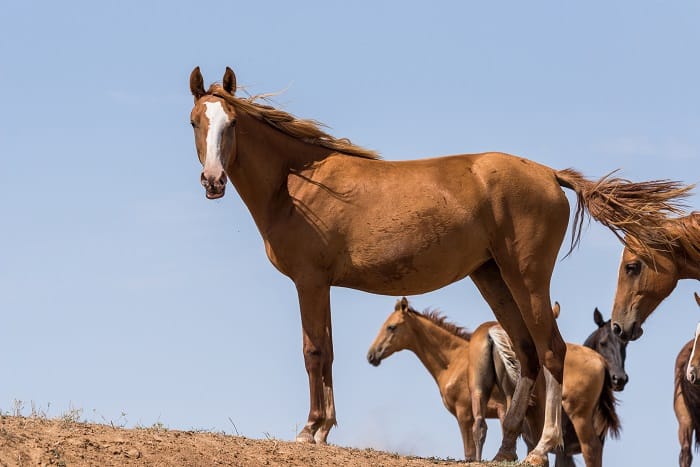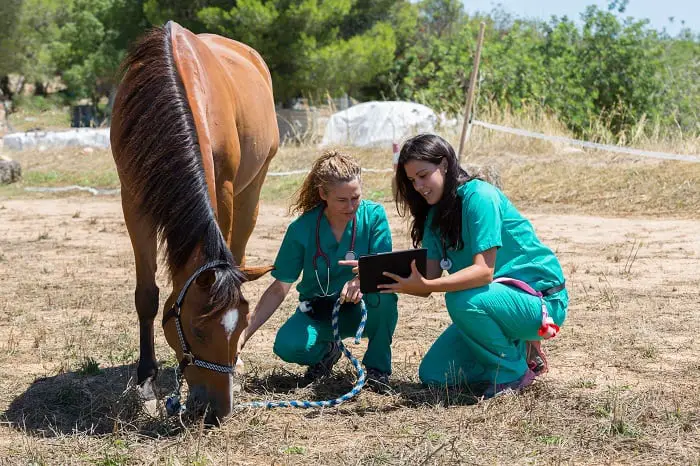Last Updated on February 28, 2023
Anyone who owns a mare knows that managing her heat cycle can be a delicate and difficult skill to master! Mares, like many other mammals, can completely change in temperament when going through their regular cycles. But at what age do mares stop going into heat? And how can we look after a mare when she is in heat? We’ve got everything you need to know right here!
As always, being informed and proactive about dealing with a mare in heat will make the actual process easier and less stressful for both the horse and the owner.
Knowing when to expect your mare’s cycles, what symptoms to expect from her, how long her cycles last, and what you can do to keep her as comfortable as possible will help you prepare for dealing with her cycles.
Knowledge and experience are your best defenses against dealing with health-related issues and situations as a horse owner.
So, look no further than this article to learn more about when mares go into heat, how to know when a mare is in heat, how long a mare is in the heat, and what you can do to help a mare in heat.
What Does it Mean When a Mare is in Heat?
When a mare is in heat, it means she is at the point in her reproductive cycle where she is receptive to being mated by the stallion. This is the stage where she is at her most fertile and is most likely to become pregnant. Within the body, the ovaries are preparing to release an egg, and the uterus is changing in preparation for receiving a fertilized egg.
Although most of us never plan on breeding from our mares, it is still essential to understand what it means when a mare is in heat. This period of her life can affect her physical and mental well-being and may mean we need to change the way we care for our mares.
How Do You Know When a Mare is in Heat?
Every horse is different, and every mare is different. Therefore, the signs that a mare is going into heat or is already in heat can vary widely from horse to horse. Luckily some shared symptoms should be easy to spot in the vast majority of mares.
As people in the horse world would say, when mares are in heat they become extra ‘mare-ish‘. This means that they typically become more irritable, grumpy, and unpredictable. A mare in heat will also do a lot of tail raising and urinate more frequently than normal.
In extreme cases, they may even lash out by biting or kicking at you or other horses. Sometimes they become more vocal, calling to their friends if they are out of sight. They can also become more sensitive around their stomach and flanks and may squeal when touched.
How Often Do Mares Come into Heat?
The reproductive cycle of a mare is defined as seasonally polyestrous. This means that she only comes into heat during the breeding season, and she will have multiple breeding cycles during that season until she falls pregnant.
So, mares do not go into heat all year round. During the fall and winter months, mares become anoestrus, which means their cycle gradually slows down and stops altogether. Then, as the weather warms up and the sun is out for longer in the spring, her reproductive cycle starts again.
Sometimes it takes a while for the reproductive cycle to become normal and predictable, and the first few cycles in early spring may be irregular and less obvious. However, by late spring your mare should be coming into heat once every three weeks.
How Long Do Mares Stay in Heat?
Typically, the average horse heat cycle length is three weeks or 21 days. Out of these twenty-one days, a mare will be obviously in the heat for five of them. These five days are when the mare is ovulating and is most receptive to being mated by a stallion. If you are hoping to breed a foal from your mare, using a mare ovulation calculator can help you determine the optimum time for your mare to be mated or inseminated.
There can be some slight variation on this 21-day cycle – every horse is unique, and some mares will deviate from this average, but it’s a good basis to start on. Remember that mares do not go through this cycle all year round, and they will typically only be on this three-week cycle from mid-spring through the end of fall.
The actual months of a mare’s cycle will vary depending on where you live and what the climate and daylight hours are like. The first reproductive cycles of spring are triggered by lengthening daylight hours, and this can vary widely around the world.
How Many Times a Year Do Horses Go into Heat?
If a mare does not become pregnant, she will go into heat every 3 weeks during the spring and summer. This cycle slows down during the fall and ceases altogether during the winter. In an average year, a mare can go into heat at least 10 times.
When Do Fillies Start Cycling?
Young mares, or fillies, reach their reproductive maturity at just 18 months of age. To start with the cycles may be irregular, but by the age of two or three, the mare should be experiencing normal heat cycles.
However, most breeders agree that this is still too young to breed from a horse. A two-year-old filly is not yet physically mature, and may not be able to support a growing foal. For this reason, it is normal to wait until a mare is at least four years old before breeding from her.
At what Age Do Mares Stop Going into Heat?
The most fertile life stage for a mare is between 4 and 12 years old. From the age of 15, her fertility starts to decrease, and many mares stop going into heat by the time they are 20-25 years old.
Older mares often suffer from poor fertility not only due to changes in the heat cycle, but also physical alterations that occur within the body. Many mare owners decide to breed a foal from their mare after she has retired from ridden work, only to find that she is unable to successfully conceive due to her age and physical condition.
How to Look After a Mare in Heat
Heat cycles are a natural part of a mare’s life and one that you will need to learn to work around. Mares experience a wide range of behavioral and physical symptoms during their reproductive cycle, which can have an impact on the way they care for their mare.
Luckily, if your mare’s heat cycle is causing severe problems, several things can be done to help ease her symptoms.
Regular Vet Checks
If your mare is showing extreme signs of aggression or irritability, make sure she gets looked over by the vet. It can be easy to write a mare’s negative behavior off as her “being in heat”, but there may be a different reason.
Sometimes her behavior may be due to an actual health impairment, injury, or illness not at all related to her cycle, such as back problems or dental issues.
Some problems can occur within the reproductive cycle that makes the mare’s symptoms worse than normal. Large follicles or cysts on the ovaries are particularly painful for the mare while she is in heat.
Supplements
There are many supplements available that help regulate your mare’s hormones and ease the symptoms of being in heat. Be sure to do your research on which one will be best for your mare, in conjunction with her behavior, her regular feed schedule, and other supplements she may be getting.
These hormone-regulating supplements may help her calm down, and they may help decrease any pain and discomfort.
Sterile Marbles
Sterile marbles are medical devices that can only be used by veterinarians. They are inserted into the uterus of the mare when she is in heat, and they trick the mare’s body into believing that she is pregnant. This then stops her regular cycles altogether.
Some horse owners have had positive experiences with sterile marbles, and some have watched their horses suffer unpleasant side effects from them. Be sure to consult your vet before deciding this is the best course of action for your mare.
Summary
Mares have a reputation for being temperamental, but they can be the best partner you’ve ever had if you know how to care for them properly. Every mare’s cycle is going to be different, and every mare is going to need different care during the time she is in heat. There are many options for managing your mare’s cycles, including ways to ease the physical and emotional symptoms of being in heat.
I hope this article helped you better understand when the mares go into heat, how to tell if a mare is in heat, how long a mare is in heat, and what you can do to help a mare in heat. If so, please share this article, and share with us your experiences dealing with mares in heat!
FAQs
Michael Dehaan is a passionate horse owner, horse rider, and lover of all things equine. He has been around horses since he was a child, and has grown to become an expert in the field. He has owned and ridden a variety of horses of different breeds, and has trained many to compete in shows and competitions. He is an experienced horseman, having worked with and competed many horses, including his own. He is an active member of the equestrian community, participating in events and teaching riding lessons.


